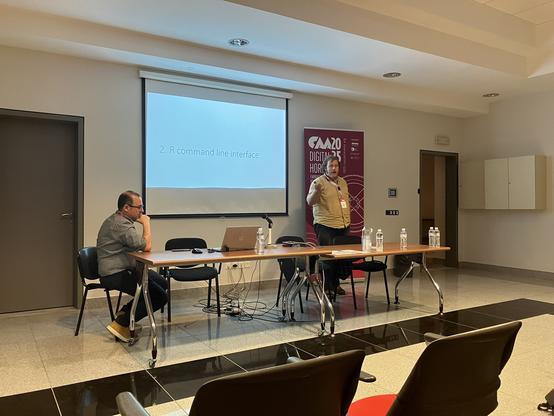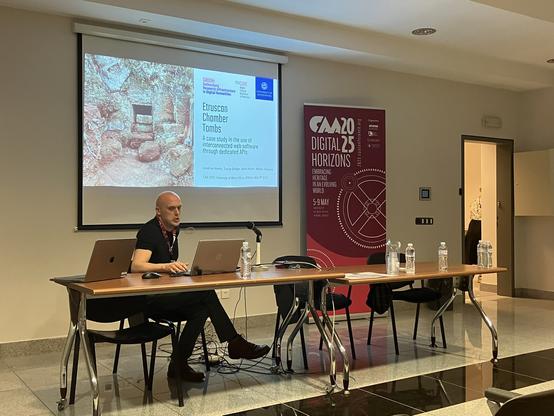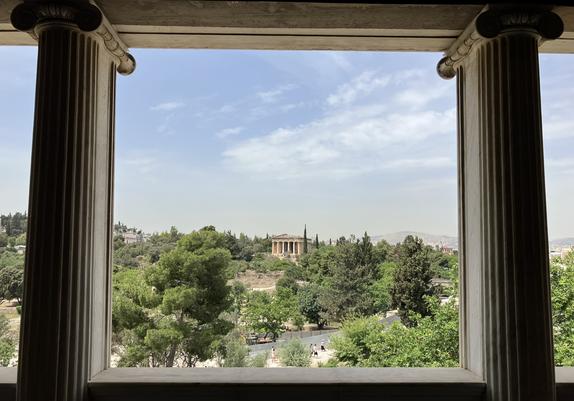@electricarchaeo It was great! Thank you!!
We are the Special Interest Group on Scientific Scripting Languages of CAA international @CAA_int. For more information, see here: https://sslarch.github.io/
Toots by scschmidt@archaeo.social
To all the new friendly faces that showed up today, please stick around! We hold monthly meetings where we talk about developments in scripting and other computer-related topics, we make resources to support the #DigitalArchaeology community, and organize workshops and conference sessions too!
We welcome anyone who wants to lead or contribute to our collective efforts to join us in our next session on July 4!
Or simply join our matrix chatroom to stay connected!
https://matrix.to/#/#caa-ssla:archaeo.social
Join us this Friday for a special presentation by @electricarchaeo, who will be talking about his work using small, practical and locally controlled LLMs! ⛏️✨🤖👾📜
Friday June 6, 2PM GMT / 4PM CEST / 10AM EST
mcgill.zoom.us/j/2320704440
Join us this Friday for a special presentation by @electricarchaeo, who will be talking about his work using small, practical and locally controlled LLMs! ⛏️✨🤖👾📜
Friday June 6, 2PM GMT / 4PM CEST / 10AM EST
mcgill.zoom.us/j/2320704440
Mark your calendars!
During our next meeting, @electricarchaeo will be presenting about his work using LLMs, including some material from his upcoming book that aims to make LLMs more accessible to archaeologists.
✨👩💻🤖🏺🤗
Friday June 6, 2PM GMT / 4PM CEST / 10AM EST
https://mcgill.zoom.us/j/2320704440
Mark your calendars!
During our next meeting, @electricarchaeo will be presenting about his work using LLMs, including some material from his upcoming book that aims to make LLMs more accessible to archaeologists.
✨👩💻🤖🏺🤗
Friday June 6, 2PM GMT / 4PM CEST / 10AM EST
https://mcgill.zoom.us/j/2320704440
These five talks together made for a great, insightful session with solid attendance and discussion, despite the shockingly late time slot we were scheduled for (18:40-20:20!). It followed on seamlessly from the equally interesting preceding one on "Chronological modelling II: formal methods and research software" organized by Eythan Levy and Thomas Huet. (7/7)
For the final talk "A command-line interface for chronological network modelling in R" Eythan Levy and Joe Roe (and Gilles Geeraerts) once more talked about an eDSL for age modelling. The #rstats package chronologr (https://github.com/joeroe/chronologr) is a (still experimental) port of the published ChronoLog (https://chrono.ulb.be) software tool.
Back to the topic of web APIs, Jonathan Westin (and Matteo Tomasini, Tristan Bridge, and Aram Karimi) demonstrated how archaeological data can shine in the hands of a team of professional back- and front-end developers. The "Etruscan Chamber tombs Portal: a case study in the use of interconnected web software through dedicated APIs" is already online (https://etruscan.dh.gu.se).
In "Open-Source Bayesian Chronological Modeling: The Role of a Domain-Specific Language" Martin Hinz (and Joe Roe) shared ideas and a prototype implementation of an eDSL for probabilistic age modelling. Not unlike OxCal (https://c14.arch.ox.ac.uk/oxcal.html), but open source.
Under the title "Untapped Potential or Unusable Complexity? Challenges of Providing APIs for Archaeologists" Lisa Steinmann (and Simon Hohl) talked about the challenges of providing useful and well-documented APIs for the web resources of the German Archaeological Institute (DAI): iDAI.gazetteer (https://gazetteer.dainst.org), iDAI.chronontology (https://chronontology.dainst.org), and
iDAI.objects arachne (https://arachne.dainst.org).
I had the honour of leading into the session with "Building a tree-walk interpreter - a didactic deep dive into the age modelling language of the currycarbon software tool". This talk was a plea to consider DSLs as useful software interfaces for archaeologists. Many archaeologists are not programmers, but knowledgeable domain experts. Targeted DSLs for tasks like age modelling, stratigraphic reconstruction or data querying could unlock modular and reproducible computational workflows for them.
Last week I was in Athens for the International Conference on Computer Applications and Quantitative Methods in #Archaeology (CAA, see @CAA_int). Under the auspices of the @CAA_SSLA special interest group Martin Hinz and I had organized a session on computational interfaces for archaeological research software. The idea was to explore the potential of Application Programming Interfaces (APIs) and Domain-Specific Languages (DSLs). Despite the nerdy topic we got 5 interesting talks: (1/7)
Thakur et al 2025: "Scientific Open-Source Software Is Less Likely to Become Abandoned Than One Might Think! Lessons from Curating a Catalog of Maintained Scientific Software" https://arxiv.org/abs/2504.18971 #nwit
It seems like someone stole a book about #ethics in #archaeology at the #saa2025 exhibition room.
I guess they really needed it?
Dear #DigitalArchaeology-sts , we will have our next meeting this Friday, 2nd May 2025!
Looking forward to seeing you all and discussing recent issues in the world of scientific scripting languages👩💻 🔍 , the CAA conference 👥 👩🏫 and what else is interesting to y'all. 🤓
Przedłużamy termin nadsyłania zgłoszeń na Konferencję CAA Poland Wrocław 2025! https://www.facebook.com/1070621108404721/posts/1209602121173285
📢 The next SIG SSLA meeting takes place this Friday, 04th April 2025, 📢
at 2pm GMT, 4 pm CEST, 10 am EST... pick your time zone 😉
We have a few topics we wish to discuss, such as updates to our TFQA project, an update to our didactic map of computational archaeology
-- don't know it yet? Check it out: https://sslarch.github.io/MapofComputationalArchaeology/ -- ,
the survey of AI projects and use cases in archaeology and our plans for this year.
Looking forward to seeing y'all! 🤗
Awesome!
Our EU Open Source Solutions Catalogue is live !
Quick reminder to our members, to please fill in the survey regarding out summer plans, that Martin sent round! 📝 🤓 ✅
Thank you! 🤗





